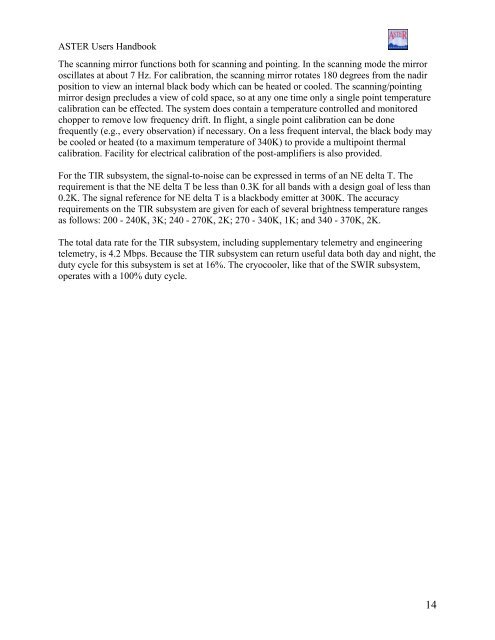Create successful ePaper yourself
Turn your PDF publications into a flip-book with our unique Google optimized e-Paper software.
<strong>ASTER</strong> Users HandbookThe scanning mirror functions both for scanning and pointing. In the scanning mode the mirroroscillates at about 7 Hz. For calibration, the scanning mirror rotates 180 degrees from the nadirposition to view an internal black body which can be heated or cooled. The scanning/pointingmirror design precludes a view of cold space, so at any one time only a single point temperaturecalibration can be effected. The system does contain a temperature controlled and monitoredchopper to remove low frequency drift. In flight, a single point calibration can be donefrequently (e.g., every observation) if necessary. On a less frequent interval, the black body maybe cooled or heated (to a maximum temperature of 340K) to provide a multipoint thermalcalibration. Facility for electrical calibration of the post-amplifiers is also provided.For the TIR subsystem, the signal-to-noise can be expressed in terms of an NE delta T. Therequirement is that the NE delta T be less than 0.3K for all bands with a design goal of less than0.2K. The signal reference for NE delta T is a blackbody emitter at 300K. The accuracyrequirements on the TIR subsystem are given for each of several brightness temperature rangesas follows: 200 - 240K, 3K; 240 - 270K, 2K; 270 - 340K, 1K; and 340 - 370K, 2K.The total data rate for the TIR subsystem, including supplementary telemetry and engineeringtelemetry, is 4.2 Mbps. Because the TIR subsystem can return useful data both day and night, theduty cycle for this subsystem is set at 16%. The cryocooler, like that of the SWIR subsystem,operates with a 100% duty cycle.14















